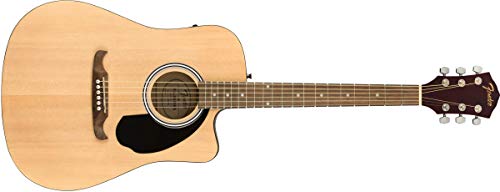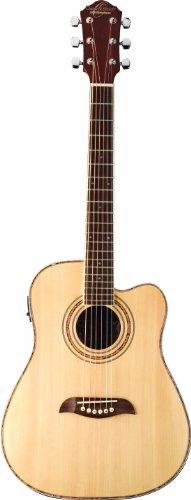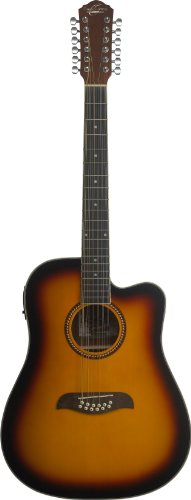8 Best Cheap Acoustic-Electric Guitars Under $200 (Budget Picks)
With only $200, you’ll need to work a little harder to track down a quality guitar. At this price, it’s dangerously easy to end up with something that sounds more like a toy than an instrument.
OR you can just let us do the hard work for you.
We’ve tested a ton of inexpensive guitars to come up with this top eight, all of which outplay their price tags.
Fender FA-125CE
Our best affordable acoustic-electric guitar is the Fender FA-125CE. It features classic Fender sound quality and style at a price that’s hard to believe. The all-laminate construction keeps it affordable, but the manufacturing experience of the brand ensures a quality sound that’s rich, balanced, and powerful.
The 8 Best Acoustic-Electric Guitars Under $200 in 2020
A $200 budget won’t get you the best of the best acoustic-electric guitar, but it doesn’t confine you to buying a child’s toy either. We’ve rounded up 8 great budget picks that even discerning players will appreciate.
1. Fender FA-125CE - Best Overall
Specifications
Topwood: Laminate Spruce
- Back and Sides: Basswood
- Body Style: Dreadnought
- Electronics: Fishman
The best way to get a quality guitar at a low price is to shop the entry-level models from well-established brands. Sure, you might make some sacrifices when it comes to tonewoods, but you’ll be reaping the benefits of decades (sometimes centuries) of manufacturing expertise.
This super affordable Fender dreadnought is a perfect example. The build quality and design are impeccable, and you’ll notice it still has that distinct Fender tone, thanks in part to the Viking bridge.
Yet the use of laminate tonewoods keeps it remarkably cheap.
The full-size dreadnought shape means the FA-125CE has excellent projection, and a cutaway provides easy access to the upper frets.
The top is laminated spruce, while the sides and back are basswood. Basswood gets a bit of an undeserved bad rap because it’s often used in cheap guitars, but in fact, it lends a nice depth and balance to the brightness of the spruce in this case.
Inside, you’ll find Fishman electronics. Like Fender, Fishman is one of the biggest names in the game. So even their basic electronics are reliable and well-engineered.
Who was it made for? As our pick for the best inexpensive acoustic-electric guitar this year, we’d venture to say this is a guitar for anyone on a budget. The tonewoods and dreadnought body style promise a classic bright acoustic sound, and the Fender design gives it great street appeal.
2. Yamaha APXT2 ¾ Thinline - Runner Up
Specifications
Topwood: Spruce
- Back and Sides: Meranti
- Body Style: ¾ APX Thinline with Cutaway
- Electronics: A.R.T. System 68
Long the master of the affordable acoustic-electric guitar, Yamaha has delivered once again with the APXT2. Give this guitar a listen, and you won’t believe it’s under $200.
The APXT2 is a ¾-size version of Yamaha’s popular APX500, and therein lies its secret. Its low price reflects its small size, not any sacrifices made in construction or design.
In many ways, the compact thinline body of this guitar is actually an advantage. It’s light and portable for guitarists on the move. Along with the slim nato neck, it’s comfortable and easy to play for smaller players and children.
The spruce top and meranti sides and back give it a classic acoustic tone, with a much fuller body than you’d expect from a little guitar. The midrange is beautifully warm, and the high notes are crisp. Of course, it lacks a little in bass and volume as compared with a full-size dreadnought.
Luckily, it’s got a set of TOP-NOTCH ELECTRONICS to compensate for any size-related shortcomings.
Yamaha’s patented Acoustic Resonance Transducer System 68 pickup is ultra-sensitive to small resonances, which gives you a more authentic amplified acoustic tone. There are also tone shaping controls and an onboard tuner.
Who was it made for? With its ¾ size, thinline body, and convenient cutaway, this guitar is perfect for an up-and-coming youngster looking for their first acoustic-electric. With a padded gig bag included in the price, it’s a great option for travelers too.
3. Carlo Robelli F550 Thinline - Best Value
Specifications
Topwood: Spruce
- Back and Sides: Mahogany
- Body Style: Thinline with Cutaway
- Electronics: Active Preamp with 3-Band EQ, Volume and Battery Check
The cheapest among the cheapest, but WORTHY OF PRAISE. This is our best-value-pick for several reasons.
Like the Yamaha above, this Carlo Robelli model has a thinline cutaway design that makes it EXCEPTIONALLY COMFORTABLE, especially for the smaller player. But with a bigger body, the F550 has a bit more depth in the low-end and enough volume to reach the cheap seats.
It has a spruce top with a mahogany back. So you’ll get a rich tone with a nice balance between warmth and brightness. The neck is solid okoume, with a comfortable C-shape profile and a fast-playing rosewood fretboard. A double-action truss rod makes it easy to adjust the neck for your needs.
The body is coated with a beautiful natural gloss finish, which really highlights the red-hued grain of the mahogany. A black rosette and die-cast chrome tuners complete the look.
The onboard electronics make it easy to tailor your sound to impress your audience. The preamp includes a 3-band EQ for bass, mid, and treble, plus a volume control.
Who was it made for? The Carlo Robelli F550 is our pick for the best value acoustic-electric guitar this year for good reason. It’s remarkably affordable without compromising on sound quality or good looks. Any guitarist on a strict budget is going to appreciate how much they get for so little.
4. Ibanez Talman TCY10E - Best for Rockstars
Specifications
Topwood: Spruce
- Back and Sides: Sapele
- Body Style: Talman Double Cutaway
- Electronics: Ibanez AEQ-2T Preamp, Under-saddle Pickup, Onboard Tuner
If you love the feel and rockstar style of an electric guitar but prefer the rich, twangy tones of an acoustic, you’re going to love this clever design from Ibanez. The Talman TCY10E manages to pair the comfort and playability of an electric guitar with a rich acoustic sound at a remarkably low price (1).
Ibanez has become an industry leader by never being afraid to innovate and collaborate with artists to make more user friendly guitars.
We can only agree with this statement. Focusing closely on the player’s needs is what separates Ibanez from the rest of the manufacturers. However, their innovations are what keeps the buyers loyal to the brand.
The rockstar appeal of this guitar comes from its unique double-cutaway shape, which immediately identifies it as a Talman. Not only does it look cool, it provides easy access to the full fretboard, for when you want to pull out those rockin’ high-note solos.
The characteristic sound of this guitar comes from the choice of tonewoods, spruce for the top and sapele for the sides and back. This gives it a clear acoustic tone, especially in the upper register, with a nice overall warmth.
One of Ibanez’s best innovations is their proprietary Advantage pins, and it’s nice to see them here on an entry-level guitar. Compared with standard pins, they make changing strings much quicker and simpler, a real advantage for new players.
Who was it made for? With its unique double-cutaway body shape, the Talman TCY10E was clearly made for aspiring rock stars. It feels like an electric guitar, sounds like an acoustic, and looks incredibly cool on stage.
5. Ibanez PN12E - Best Small Body
Specifications
Topwood: Sapele
- Sides and Back: Nyatoh
- Body Style: Parlor
- Electronics: AEQ2T Preamp with Built-in Tuner
A parlor guitar is a wonderful little shape, whether you’re a small guitarist or just want a fun and comfortable playing experience. We particularly love the PN12E from Ibanez for its ultra-warm sound.
This guitar is just begging to be strummed around a blazing fire on a chilly night.
Its distinctly warm tones are a result of the tonewoods. An unusual sapele top is paired with nyatoh sides and back. Much like an all-mahogany guitar, this combination of relatively dense tonewoods means a richer, warmer sound, especially in the midtones and low end. This is a really nice way to get more depth from a small body guitar.
Not that you should feel confined to the campfire. For hitting the stage, the PN12E’s built-in electronics are more than up to the task. It features Ibanez’s extremely popular AEQ2T preamp and onboard tuner coupled with an under-saddle pickup. For you, that means none of that characteristic warm tone is lost upon amplification.
Who was it made for? The compact and comfortable parlor body style makes this a great guitar for beginners, especially for children. But even more advanced players looking for a low-cost model with that classic all-mahogany warmth will appreciate this instrument as a reliable second.
6. Oscar Schmidt OG1CE - Best for Folk Music
Specifications
Topwood: Select Spruce
- Back and Sides: Catalpa
- Body Style: ¾-size Dreadnought
- Electronics: Barcus Berry EQ4T
Folk music and the acoustic guitar are a match made in heaven, so we thought long and hard about this category. A great folk guitar needs rich resonance, a full-bodied sound, and just a hint of that steel string twang. And the Oscar Schmidt OG1CE delivers on all fronts, at a price that can’t be beat.
The company has been around since 1871, making string instruments of all types, which means they’re coming up on 150 years of luthier experience! No wonder they’re able to make a ¾-size guitar with laminate construction sound this good.
The select spruce top gives it a bright and punchy sound, and it’s matched with catalpa for the sides and back. Catalpa is a tonewood that has become associated with discount instruments.
But that’s NOT due to a lack in quality.
Catalpa is actually quite nice as a tonewood, with a long history in classical Chinese stringed instruments. It adds a bit of warmth and a surprising power to the low end of this guitar.
The only possible downside to this model is its narrow nut width. It’s great for children or players with small hands, but it can make chording difficult for average adults.
Who was it made for? With its narrow neck and small body, the OG1CE is a perfect starter acoustic-electric guitar for the young player in your life. It’s a child-sized guitar with a full-size sound that even hardened adults can’t help but appreciate.
7. Luna Guitars Safari Tribal - Best for Travel
Specifications
Topwood: Spruce
- Back and Sides: Mahogany
- Body Style: ¾-size Dreadnought
- Electronics: Luna SL3 with Tuner
With a name like Safari, it’s clear this is a guitar made for adventurers. Ok, maybe don’t take it to an actual safari, but you know what I mean.
It’s light, compact and durable, and a gig bag is included!
The Luna Safari Tribal is a ¾-size travel guitar with a pleasingly full and balanced sound, thanks to its tonewood combination of a spruce top and mahogany sides.
Okay, the travel size means it lacks a little in volume, but that’s where the plug-and-play electronics come in. The Luna SL3 preamp includes a 3-band EQ, volume control, and phase switch for all your tone-shaping needs. There’s even a built-in tuner, so you always sound your best.
Where this guitar really shines is in the details, perhaps because Luna was co-founded by a stained glass artist. The Tobacco Sunburst satin finish has a gorgeous red-orange hue that highlights the elegant rosette around the soundhole. We especially love the pearloid inlays in the fretboard, which are shaped like phases of the moon.
Who was it made for? This guitar is for travelers who don’t want to sacrifice good looks in exchange for portability. The Safari Tribal guitar is perfect for traveling musicians to bring from gig to gig, because unlike many travel guitars, its beauty is plenty stage worthy.
8. Oscar Schmidt OD312CE - Best 12-String
Specifications
Topwood: Select Spruce
- Back and Sides: Mahogany
- Body Style: Dreadnought
- Electronics: Barcus Berry EQ4T
For a richly layered, full-bodied sound, nothing but a 12-string will do. But finding a 12-string acoustic-electric for under $200 isn’t easy.
Luckily, Oscar Schmidt CAME TO OUR RESCUE.
They’ve managed to craft an impressive sounding dreadnought at a budget that’s hard to believe.
The top is a select spruce, which is paired with mahogany for the sides and back. This classic tonewood combo gives it a well-balanced sound with excellent resonance and long sustain. The solid mahogany neck feels nice and sturdy, which is extra important when standing up to the pressure of double the strings.
The design is simple and classic, with the popular dreadnought body shape and a single cutaway that makes it easy to play the high frets. It comes in 7 different colors, from basic natural wood to funky bright blue, all topped with a shiny high-gloss finish for great stage presence.
Still, we love the rich orange of the Tobacco Sunburst model.
Inside, you’ll find Barcus Berry electronics, including the popular EQ4T preamp and an onboard tuner. Given that 12-string guitars are notoriously difficult to get in tune and keep in tune, this is a convenient addition that will make your life a lot easier (2).
Who was it made for? 12-string guitars are unique instruments, with special challenges and equally special results. Not every acoustic guitarist will want to take one on, but if you’re looking for an entry-level model on which to learn, we can’t recommend this one highly enough.
How to Choose the Best Acoustic-Electric Guitar Under $200
With a budget of 200 dollars, you can still get a high-quality acoustic-electric guitar, but you’re also going to find a lot of terrible instruments in your price range.
Read this buyer’s guide for some of our best tips for finding those diamond guitars in the rough that is the budget guitar market.
Choose a well-established brand.
When it comes to finding the best cheap acoustic-electric guitar, it’s always worth looking for a well-established brand. Most of the top brands offer affordable entry-level models, which is a great starting point.
The companies that have been around a long time have years of experience designing and manufacturing guitars. They best understand all the little details that contribute to a guitar’s sound, and they can use this knowledge to get the most sound out of an instrument, even without the use of expensive tonewoods.
Another good reason to choose a top brand is that they have reputations to uphold. It does them no good to have a sub-par instrument in their lineup.
Consider a small body instrument.
For less than $200, many of the guitars you’ll consider will have smaller bodies.
DON’T SHY AWAY from this option, especially knowing that the built-in electronics make it easy to up the volume (3).
True, you may miss out on the big, booming sound of a dreadnought or jumbo. But a smaller guitar, like a thinline, ¾-size dreadnought, or parlor, means the manufacturers can use high-quality materials while keeping costs low.
On top of that, small guitars have certain advantages. They’re fun to play because they fit so comfortably in your arms, and they’re a natural choice for travelers or children.
With this budget, expect laminate tonewoods.
For under 200 dollars, you can expect the use of laminate tonewoods. It’s just too difficult to source and manufacture with solid wood at this price range.
Have no fear though, laminates can still yield fine-sounding guitars, especially when combined with expert manufacturing and design.
If you’re buying a guitar for travel, even better.
Laminates tend to do better in their battle against the elements. Because they’re comprised of multiple layers and go through a combination of heat, pressure and adhesive processes, they’re more resilient.
Basically, unlike solid wood, laminates won’t split and crack when your travel takes you to different climates (4).
If you prefer a solid wood soundboard and have a little flexibility with your budget, check out our suggestions for guitars worth $300 and these models instead if you have a slightly higher budget.
Electronics
Most budget acoustic-electric guitars will have a fairly basic electronics set-up. But this isn’t a bad thing. For a beginner, these simple set-ups have more than enough features and are easy to use.
That means that they also tend to be less sensitive to damage and cheaper and easier to fix than more complex systems (5).
If you’re buying an acoustic-electric because you plan to hit the stage, you’ll probably enjoy playing with a preamp that has a few tone-shaping features, like a multi-band EQ and phase switch. These let you adjust your sound on the fly.
If you’re a new player, a built-in tuner is a really convenient option, because you probably haven’t had a lot of practice tuning by ear.
This goes double if you’re buying a 12-string, because these are especially prone to falling out of tune.
FAQs
Yes, cheap acoustic-electric guitars are worth buying if you’re a beginner. They won’t have the same premium sound as an expensive guitar, but they’re a perfect low-commitment learning tool.
You can expect the best inexpensive acoustic guitar to last about 10 years, but this can vary a lot depending on how you treat your guitar. However, unlike expensive guitars, it won’t sound better with age.
The biggest difference between a cheap guitar and an expensive guitar is the quality of materials. Expensive guitars are also more likely to be handmade by skilled craftsmen, while cheap guitars are typically factory-made.
References
- Brill, J.M. (2015, November 2). A Brief History of Ibanez Guitars: From Importer to Industry Leader. Retrieved from https://reverb.com/ca/news/a-brief-history-of-ibanez-guitars?locale=en-CA
- Millevoi, N. (2016, December 3). An Introduction to the Wide World of Alternate 12-String Guitar Tunings. Retrieved from https://flypaper.soundfly.com/play/an-introduction-to-the-wide-world-of-alternate-12-string-guitar-tunings/
- Owens, J. (n.d.). The Acoustic Body Shapes You Should Know. Retrieved from https://www.fender.com/articles/gear/the-acoustic-body-shapes-you-should-know
- Beattie, S. (2018, August 10). Acoustic Guitars: Solid Tops vs. Laminated Tops. Retrieved from https://blog.andertons.co.uk/learn/acoustic-guitars-solid-tops-vs-laminated-tops
- Drake, G. (2012, June 8). Acoustic Amplification: The Newbie’s Guide. Retrieved from https://www.premierguitar.com/articles/Acoustic_Amplification_The_Newbies_Guide
I found music through childhood piano lessons but was lucky enough to learn guitar on my dad’s vintage ‘60s Gibson acoustic. These days I’m more of a music appreciator than a music player, and I’m fortunate to live in a place with a great indie scene. In my spare time, I love trail running, rock climbing, drinking coffee, doing crossword puzzles, and hanging out with my quirky little dog.





